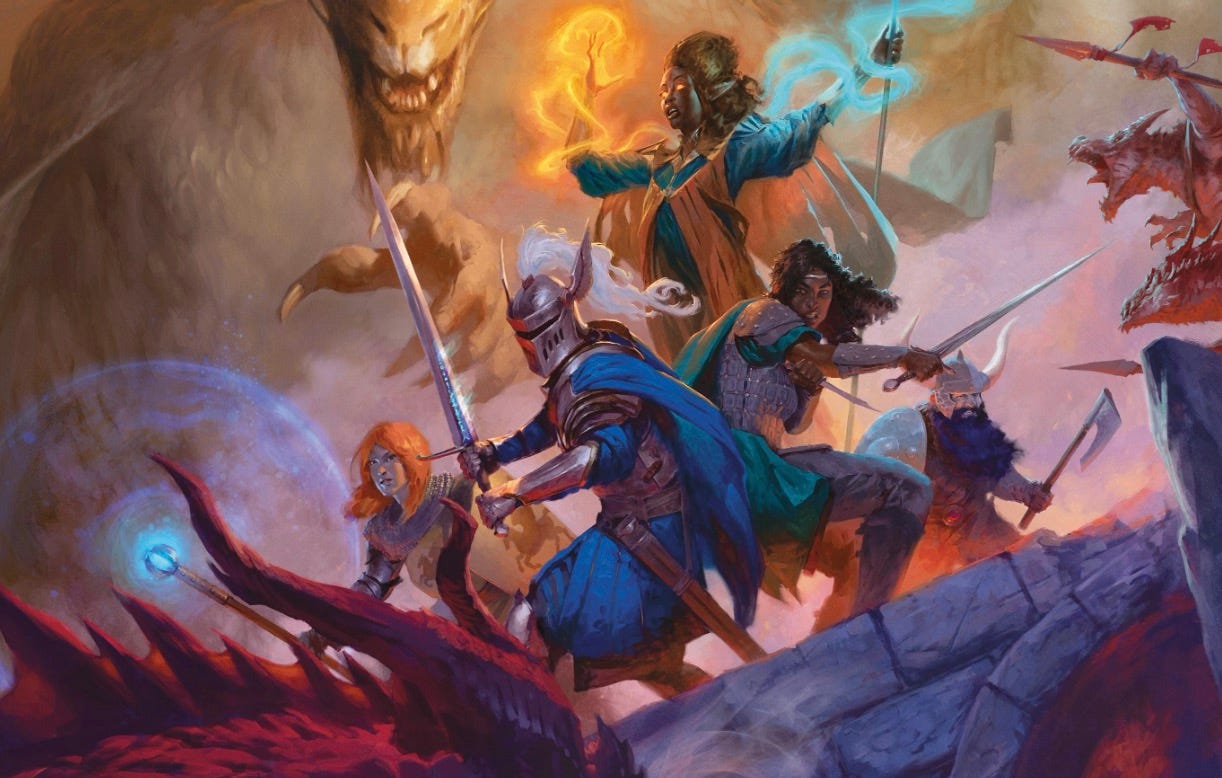Solo Guide to Dungeons and Dragons
Tips and Tricks to play solo
🔎 Find more content here
🔴 Youtube
🟣 Apple Podcast
🟢 Spotify Podcast
⚫ Patreon
Today I want to talk about how to play Dungeons & Dragons solo. We’ll go over how to create your character (or characters), how many you should play with, how to handle balancing encounters, and what to do with the meta information you inevitably learn when you’re both the player and the DM. I’ll also share what I’d like to cover next in this series.
Choosing Your Party
When you play a published 5e adventure, the book generally assumes four to six players. So as a solo player, you have a few options: run four characters, run just one, or run a smaller party like two or three. Each approach changes how the game feels.
Option 1: A Full Party (Four Characters)
Pros:
You don’t need to change the adventure very much. The encounter difficulty is already tuned for this.
You can build the exact party you want, with all the synergy, roles, and personalities you enjoy. Something you can’t always do in a group, where everyone picks their own class.
Cons:
You have to manage all the spells, traits, abilities, and inventory of four characters, plus the NPCs and monsters.
If you’re not already very comfortable with the rules, gameplay becomes slow because you constantly look things up.
Works better for short campaigns or one-shots. For longer adventures, it can get tiring.
If you’re a very experienced player and know the classes well, this can actually be very fun. But it’s a lot to juggle.
Option 2: One Character
Pros:
Extremely easy to manage.
You can really embody the character and invest in their personality and story.
Cons:
You lose party synergy. You don’t have someone to heal you, buff you, or take hits for you.
You must rebalance almost every encounter, because most fights are too hard for a solo character by default.
To make this work, you can:
Reduce the number of enemies
Lower a monster’s AC or HP
Remove multi-attack
Or start at a higher level (for example, level 3 so you have your subclass abilities)
This works, but requires constant adjustment.
Option 3: Two Characters (Recommended)
This is the approach I use personally. It’s the best of both worlds.
Why it works:
You still get synergy: for example, a martial frontline character + a support spellcaster.
You only manage two sheets, which is manageable.
Balancing encounters becomes much easier. Most of the time you can simply divide the number of enemies by two.
It has a strong narrative appeal—think Frodo and Sam, Batman and Robin, Geralt and his bard companion.
This is usually the easiest and most enjoyable solo setup.
Balancing Encounters
Once you’ve chosen your party size, you will need to do some balancing—especially if you use fewer than four characters.
For single characters:
Reduce AC, HP, and damage output of enemies
Remove multi-attacks
Or start your character at a higher level to avoid constant tweaking
For two characters:
Split enemy group sizes in half
Adjust on the fly only if something feels off
It doesn’t have to be perfect. If a fight is too hard, adjust. If it’s too easy, adjust. You’re the player and the DM—flexibility is part of the fun.
Dealing With Meta-Knowledge
Solo players always have meta information since they’re reading the adventure. The trick is not to fight that—it’s exhausting and doesn’t work anyway. Instead, embrace it, but use dice rolls to determine what your character actually learns or notices.
Know a monster that has resistance to fire? Just don’t use fire spells. Don’t pretend you don’t know.
Know a chest is a mimic? Let your character’s personality decide what they do. Maybe they always open chests. Roll the attack and take the consequences.
Know there’s a secret door? Roll for Perception. If you fail, you fail.
Let dice, not willpower, decide outcomes. This keeps the game fun and prevents internal arguments like “Do I pretend I don’t know this?”
What’s Coming Next
I’d like to create a series where I pick a specific published adventure and show how to run it solo, chapter by chapter. I’ll create two characters, explain how I balance encounters, how I run NPCs, and how I make decisions when multiple quest paths open up.
If you’d be interested in that, let me know—and if you have a favorite adventure you’d like me to cover, leave a comment or send me a message.






Hopefully you decide to go ahead with breaking down adventures in the solo style. Seeing exactly how someone breaks it down will help many solo players, I believe. I can’t wait to see how it’s done.
Thank you for the ideas and looking forward to seeing how a playthrough works